Full Viscous Modeling in Generalized Coordinates of Heat Conducting Flows in Rotating Systems
| dc.contributor.author | Kaul, Upender K. | |
| dc.contributor.author | Shreeve, Raymond P. | |
| dc.date.accessioned | 2019-04-11T20:21:35Z | |
| dc.date.available | 2019-04-11T20:21:35Z | |
| dc.date.issued | 1996 | |
| dc.identifier.citation | Kaul, Upender K., and Raymond P. Shreeve. "Full viscous modeling in generalized coordinates of heat conducting flows in rotating systems." Journal of thermophysics and heat transfer 10.4 (1996): 621-626. | en_US |
| dc.identifier.uri | https://hdl.handle.net/10945/61957 | |
| dc.description | The article of record as published may be found at http://dx.doi.org/10.2514/3.838 | en_US |
| dc.description | Presented as Paper 93-2579 at the AIAA/SAE/ASME/ASEE 29th Joint Propulsion Conference, Monterey, CA, June 28-30, 1993 | |
| dc.description.abstract | A computational and analytical study has been carried out that assesses viscous formulations used currently in the state-of-the-art and widely used incompressible viscous flow solution methodologies in generalized curvilinear coordinates. These methodologies use a powerful and simple approximate factorization delta scheme. The conventional thin (viscous) layer form used for steady-state flows is analyzed and is then improved to extend its applicability, in general, to the solution of unsteady incompressible flows. Then, this improved thin-layer formulation is further extended to include more terms of the same order that are ignored in the thin-layer approximation because of the limitation imposed by the use of a conservation form of the viscous flux vector. This is achieved by recasting the viscous vector in nonconservation form. The resulting formulation represents the full-viscous (FV) formulation (except for higherorder cross-derivative terms). Solutions with the full-viscous, improved, and conventional thin-layer formulations are shown to be different, even for laminar heat conducting flow. Also, the steady state full-viscous solutions with and without the cross-derivative terms are compared and are found to be practically the same. This delineates the need, in general, for the FV formulation for turbulent flows, where turbulent viscosity variation in space is large. The methodology developed here is then used to compute flow in a rotating square duct with fast and slow rotation. The limiting solutions obtained are compared with the analytic limiting solutions and previously obtained reduced numerical solutions. Agreement is shown to be very good. | en_US |
| dc.description.sponsorship | U.S. Naval Postgraduate School | en_US |
| dc.format.extent | 6 p. | en_US |
| dc.publisher | AIAA | en_US |
| dc.rights | This publication is a work of the U.S. Government as defined in Title 17, United States Code, Section 101. Copyright protection is not available for this work in the United States. | en_US |
| dc.title | Full Viscous Modeling in Generalized Coordinates of Heat Conducting Flows in Rotating Systems | en_US |
| dc.type | Article | en_US |
| dc.contributor.corporate | Naval Postgraduate School (U.S.) | en_US |
| dc.description.funder | NPS Contract N62271-93-M-3836 | en_US |





